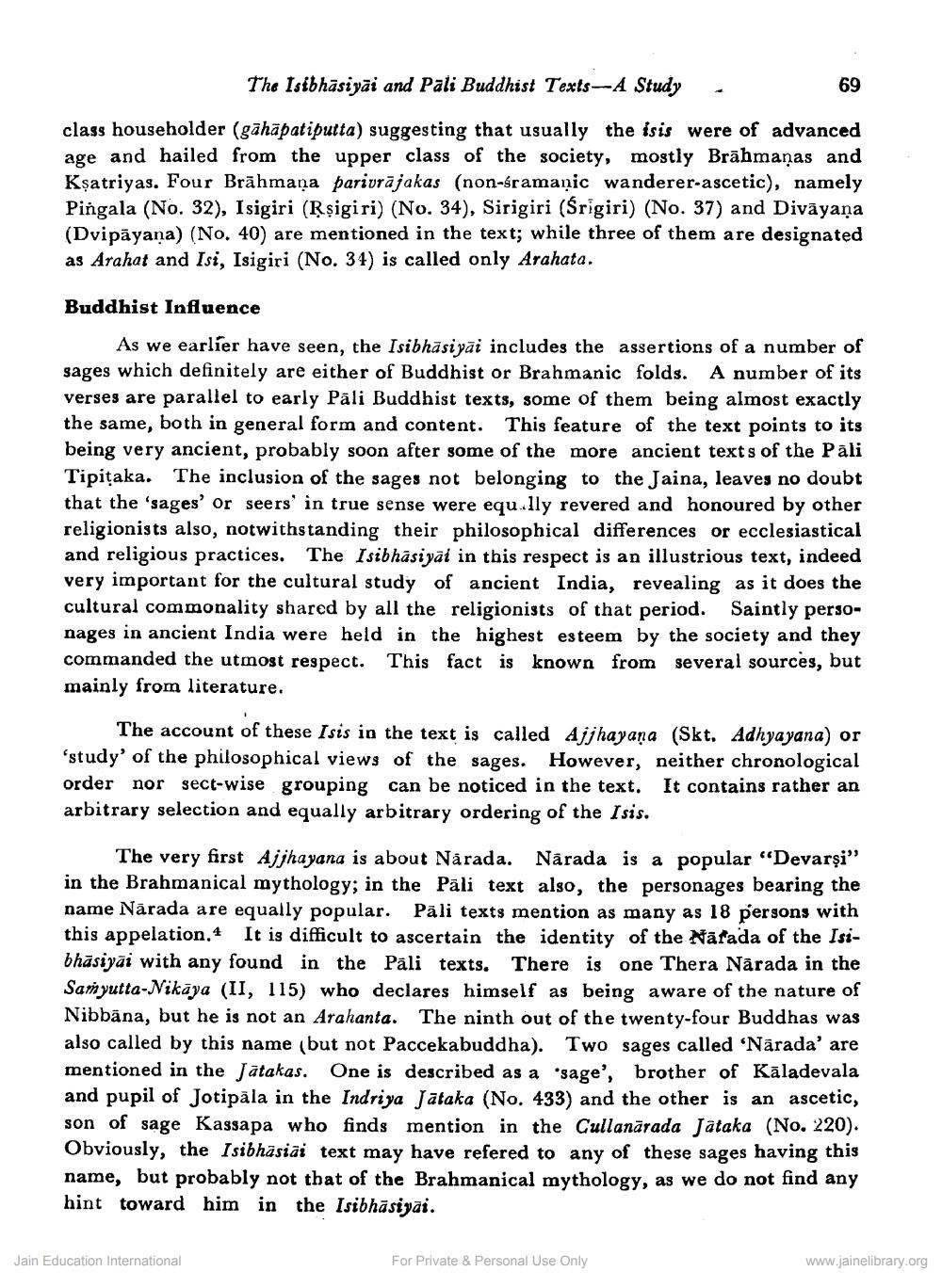Book Title: Isibhasiyai and Pali Buddhist Texts A Study Author(s): C S Upasak Publisher: Z_Aspect_of_Jainology_Part_3_Pundit_Dalsukh_Malvaniya_012017.pdf View full book textPage 2
________________ The Isibhāsiyai and Pali Buddhist Texts --A Study class householder (gāhāpatiputta) suggesting that usually the isis were of advanced age and hailed from the upper class of the society, mostly Brāhmaṇas and Kșatriyas. Four Brāhmaṇa parivrājakas (non-śramanic wanderer-ascetic), namely Pingala (No. 32), Isigiri (Rsigiri) (No. 34), Sirigiri (Srigiri) (No. 37) and Divāyana (Dvipāyana) (No. 40) are mentioned in the text; while three of them are designated as Arahat and Isi, Isigiri (No. 34) is called only Arahata. Buddhist Influence As we earlier have seen, the Isibhāsiyāi includes the assertions of a number of sages which definitely are either of Buddhist or Brahmanic folds. A number of its verses are parallel to early Päli Buddhist texts, some of them being almost exactly the same, both in general form and content. This feature of the text points to its being very ancient, probably soon after some of the more ancient texts of the Pāli Tipitaka. The inclusion of the sages not belonging to the Jaina, leaves no doubt that the 'sages' or seers' in true sense were equilly revered and honoured by other religionists also, notwithstanding their philosophical differences or ecclesiastical and religious practices. The Isibhāsiyāi in this respect is an illustrious text, indeed very important for the cultural study of ancient India, revealing as it does the cultural commonality shared by all the religionists of that period. Saintly personages in ancient India were held in the highest esteem by the society and they commanded the utmost respect. This fact is known from several sources, but mainly from literature. The account of these Isis in the text is called Ajjhayana (Skt. Adhyayana) or 'study of the philosophical views of the sages. However, neither chronological order nor sect-wise grouping can be noticed in the text. It contains rather an arbitrary selection and equally arbitrary ordering of the Isis. The very first Ajjhayana is about Närada. Narada is a popular “Devarşi" in the Brahmanical mythology; in the Pāli text also, the personages bearing the name Nārada are equally popular. Pāli texts mention as many as 18 persons with this appelation.4 It is difficult to ascertain the identity of the Nātada of the Isibhāsiyai with any found in the Pali texts. There is one Thera Nárada in the Samyutta-Nikāya (II, 115) who declares himself as being aware of the nature of Nibbāna, but he is not an Arahanta. The ninth out of the twenty-four Buddhas was also called by this name but not Paccekabuddha). Two sages called 'Nārada' are mentioned in the Jatakas. One is described as a 'sage', brother of Kāladevala and pupil of Jotipāla in the Indriya Jataka (No. 433) and the other is an ascetic, son of sage Kassapa who finds mention in the Cullanārada Jataka (No. 220). Obviously, the Isibhäsiäi text may have refered to any of these sages having this name, but probably not that of the Brahmanical mythology, as we do not find any hint toward him in the Isibhāsiyai. Jain Education International For Private & Personal Use Only www.jainelibrary.orgPage Navigation
1 2 3 4 5 6
